《管理学》课程PPT教学课件(Management, 7th Edition)Chapter 09 PLANNING TOOLS AND TECHNIQUES
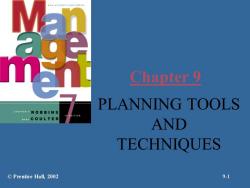
Man Chapter 9 PLANNING TOOLS ROB B INS ACOULTER AND TECHNIQUES ©Prentice Hall,2002 9-1
Chapter 9 PLANNING TOOLS AND TECHNIQUES © Prentice Hall, 2002 9-1
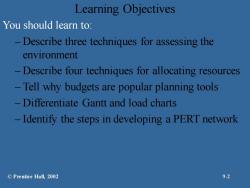
Learning Objectives You should learn to: -Describe three techniques for assessing the environment Describe four techniques for allocating resources Tell why budgets are popular planning tools Differentiate Gantt and load charts -Identify the steps in developing a PERT network ©Prentice Hall,.2002 9-2
Learning Objectives You should learn to: – Describe three techniques for assessing the environment – Describe four techniques for allocating resources – Tell why budgets are popular planning tools – Differentiate Gantt and load charts – Identify the steps in developing a PERT network © Prentice Hall, 2002 9-2
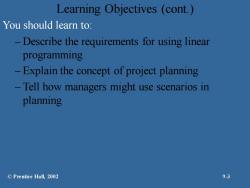
Learning Objectives (cont. You should learn to: -Describe the requirements for using linear programming Explain the concept of project planning Tell how managers might use scenarios in planning ©Prentice Hall,.2002 9-3
Learning Objectives (cont.) You should learn to: – Describe the requirements for using linear programming – Explain the concept of project planning – Tell how managers might use scenarios in planning © Prentice Hall, 2002 9-3
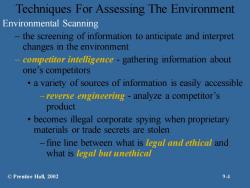
Techniques For Assessing The Environment Environmental Scanning the screening of information to anticipate and interpret changes in the environment competitor intellligence -gathering information about one's competitors a variety of sources of information is easily accessible reverse engineeriing-analyze a competitor's product becomes illegal corporate spying when proprietary materials or trade secrets are stolen -fine line between what is legall and ethicall and what is legal but unethical ©Prentice Hall,2002 9-4
Techniques For Assessing The Environment Environmental Scanning – the screening of information to anticipate and interpret changes in the environment – competitor intelligence - gathering information about one’s competitors • a variety of sources of information is easily accessible – reverse engineering - analyze a competitor’s product • becomes illegal corporate spying when proprietary materials or trade secrets are stolen – fine line between what is legal and ethical and what is legal but unethical © Prentice Hall, 2002 9-4

Assessing The Environment (cont. Environmental Scanning (cont.) -globall scanning-screening of information on global forces that might affect an organization that has global interests requires more extensive procedures than those used for scanning the domestic environment ©Prentice Hall,.2002 9-5
Assessing The Environment (cont.) Environmental Scanning (cont.) – global scanning - screening of information on global forces that might affect an organization that has global interests • requires more extensive procedures than those used for scanning the domestic environment © Prentice Hall, 2002 9-5
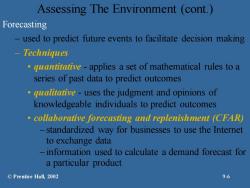
Assessing The Environment (cont. Forecasting used to predict future events to facilitate decision making Techniques quantittive -applies a set of mathematical rules to a series of past data to predict outcomes qudllittive-uses the judgment and opinions of knowledgeable individuals to predict outcomes collaborative forecasting and replenishment (CFAR) standardized way for businesses to use the Internet to exchange data -information used to calculate a demand forecast for a particular product ©Prentice Hall,2002 9-6
Assessing The Environment (cont.) Forecasting – used to predict future events to facilitate decision making – Techniques • quantitative - applies a set of mathematical rules to a series of past data to predict outcomes • qualitative - uses the judgment and opinions of knowledgeable individuals to predict outcomes • collaborative forecasting and replenishment (CFAR) – standardized way for businesses to use the Internet to exchange data – information used to calculate a demand forecast for a particular product © Prentice Hall, 2002 9-6
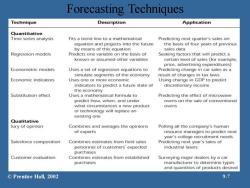
Forecasting Techniques Technique Description Application Quantitative Time series analysis Fits a trend line to a mathematical Predicting next quarter's sales on equation and projects into the future the basis of four years of previous by means of this equation sales data Regression models Predicts one variable on the basis of Seeking factors that will predict a known or assumed other variables certain level of sales (for example, price,advertising expenditures) Econometric models Uses a set of regression equations to Predicting change in car sales as a simulate segments of the economy result of changes in tax laws Economic indicators Uses one or more economic Using change in GDP to predict indicators to predict a future state of discretionary income the economy Substitution effect Uses a mathematical formula to Predicting the effect of microwave predict how,when,and under ovens on the sale of conventional what circumstances a new product ovens or technology will replace an existing one Qualitative Jury of opinion Combines and averages the opinions Polling all the company's human of experts resource managers to predict next year's college recruitment needs Salesforce composition Combines estimates from field sales Predicting next year's sales of personnel of customers'expected industrial lasers purchases Customer evaluation Combines estimates from established Surveying major dealers by a car purchases manufacturer to determine types and quantities of products desired ©Prentice Hall,.2002 9-7
Forecasting Techniques © Prentice Hall, 2002 9-7
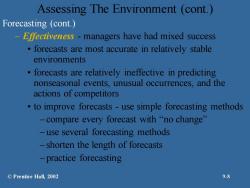
Assessing The Environment (cont. Forecasting (cont.) -Efectiveness -managers have had mixed success forecasts are most accurate in relatively stable environments forecasts are relatively ineffective in predicting nonseasonal events,unusual occurrences,and the actions of competitors to improve forecasts use simple forecasting methods -compare every forecast with "no change" -use several forecasting methods -shorten the length of forecasts -practice forecasting ©Prentice Hall,2002 9-8
Assessing The Environment (cont.) Forecasting (cont.) – Effectiveness - managers have had mixed success • forecasts are most accurate in relatively stable environments • forecasts are relatively ineffective in predicting nonseasonal events, unusual occurrences, and the actions of competitors • to improve forecasts - use simple forecasting methods – compare every forecast with “no change” – use several forecasting methods – shorten the length of forecasts – practice forecasting © Prentice Hall, 2002 9-8
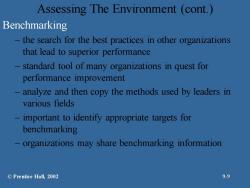
Assessing The Environment (cont.) Benchmarking the search for the best practices in other organizations that lead to superior performance standard tool of many organizations in quest for performance improvement analyze and then copy the methods used by leaders in various fields important to identify appropriate targets for benchmarking organizations may share benchmarking information ©Prentice Hal,2002 9-9
Assessing The Environment (cont.) Benchmarking – the search for the best practices in other organizations that lead to superior performance – standard tool of many organizations in quest for performance improvement – analyze and then copy the methods used by leaders in various fields – important to identify appropriate targets for benchmarking – organizations may share benchmarking information © Prentice Hall, 2002 9-9
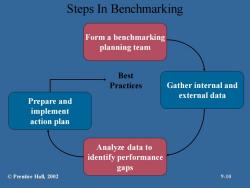
Steps In Benchmarking Form a benchmarking planning team Best Practices Gather internal and external data Prepare and implement action plan Analyze data to identify performance gaps ©Prentice Hall,2002 9-10
Steps In Benchmarking Form a benchmarking planning team Prepare and implement action plan Gather internal and external data Analyze data to identify performance gaps Best Practices © Prentice Hall, 2002 9-10
按次数下载不扣除下载券;
注册用户24小时内重复下载只扣除一次;
顺序:VIP每日次数-->可用次数-->下载券;
- 《管理学》课程PPT教学课件(Management, 7th Edition)Chapter 08 STRATEGIC MANAGEMENT.ppt
- 《管理学》课程PPT教学课件(Management, 7th Edition)Chapter 07 FOUNDATIONS OF PLANNING.ppt
- 《管理学》课程PPT教学课件(Management, 7th Edition)Chapter 06 DECISION MAKING:THE ESSENCE OF THE MANAGER’S JOB.ppt
- 《管理学》课程教学资源(课件讲义)Stephen P.Robbins(9)Chapter 2 Management Yesterday and Today.pdf
- 《管理学》课程教学资源(课件讲义)Stephen P.Robbins(9)Chapter 1 Introduction to Management and Organizations.pdf
- 《管理学》课程教学资源(教师手册)Stephen P.Robbins(9)CHAPTER TWO Management Yesterday.pdf
- 《管理学》课程教学资源(教师手册)Stephen P.Robbins(9)CHAPTER ONE Introduction to Management.pdf
- 《管理学》课程PPT教学课件(Management)Stephen P.Robbins(9)第十二章 人力资源管理 Human Resource Management.ppt
- 《管理学》课程PPT教学课件(Management)Stephen P.Robbins(9)第十章 组织结构与设计 Organizational Structure and Design.ppt
- 《管理学》课程PPT教学课件(Management)Stephen P.Robbins(9)第十五章 理解群体与团队 Understanding Groups and Teams.ppt
- 《管理学》课程PPT教学课件(Management)Stephen P.Robbins(9)第十九章 运营及价值链管理 Operations and Value Chain Management.ppt
- 《管理学》课程PPT教学课件(Management)Stephen P.Robbins(9)第三章 组织文化与环境——约束力量 Organizational Culture and Environment - The Constraints.ppt
- 《管理学》课程PPT教学课件(Management)Stephen P.Robbins(9)第二章 管理的昨天和今天 Management Yesterday and Today.ppt
- 《管理学》课程PPT教学课件(Management)Stephen P.Robbins(9)第五章 社会责任与道德管理 Social Responsibility and Managerial Ethics.ppt
- 《管理学》课程PPT教学课件(Management)Stephen P.Robbins(9)第四章 全球环境中的管理 Managing in a Global Environment.ppt
- 《管理学》课程PPT教学课件(Management)Stephen P.Robbins(9)第六章 制定决策——管理者工作的实质 Decision-Making - The Essence of the Manager’s Job.ppt
- 《管理学》课程PPT教学课件(Management)Stephen P.Robbins(9)第八章 战略管理 Strategic Management.ppt
- 《管理学》课程PPT教学课件(Management)Stephen P.Robbins(9)第十六章 激励员工 Motivating Employees.ppt
- 《管理学》课程PPT教学课件(Management)Stephen P.Robbins(9)第十一章 管理沟通与信息技术 Communication and Information Technology.ppt
- 《管理学》课程PPT教学课件(Management)Stephen P.Robbins(9)第一章 管理与组织导论 Introduction to Management and Organizations.ppt
- 《管理学》课程PPT教学课件(Management, 7th Edition)Chapter 10 ORGANIZATIONAL STRUCTURE AND DESIGN.ppt
- 《管理学》课程PPT教学课件(Management, 7th Edition)Chapter 11 MANAGERIAL COMMUNICATION AND INFORMATION TECHNOLOGY.ppt
- 《管理学》课程PPT教学课件(Management, 7th Edition)Chapter 12 HUMAN RESOURCE MANAGEMENT(HRM).ppt
- 《管理学》课程PPT教学课件(Management, 7th Edition)Chapter 13 MANAGING CHANGE AND INNOVATION.ppt
- 《管理学》课程PPT教学课件(Management, 7th Edition)Chapter 14 FOUNDATIONS OF BEHAVIOR.ppt
- 《管理学》课程PPT教学课件(Management, 7th Edition)Chapter 15 UNDERSTANDING GROUPS AND TEAMS.ppt
- 《管理学》课程PPT教学课件(Management, 7th Edition)Chapter 16 MOTIVATING EMPLOYEES.ppt
- 《管理学》课程PPT教学课件(Management, 7th Edition)Chapter 18 FOUNDATIONS OF CONTROL.ppt
- 《管理学》课程PPT教学课件(Management, 7th Edition)Chapter 19 OPERATIONS AND VALUE CHAIN MANAGEMENT.ppt
- 《管理学》课程PPT教学课件(Management, 7th Edition)Chapter 20 CONTROLLING FOR ORGANIZATIONAL PERFORMANCE.ppt
- 《管理学》课程教学资源(实验讲义)企业竞争模拟攻略篇.pdf
- 《管理学》课程教学资源(习题与答案)第1章 管理活动与管理理论.doc
- 《管理学》课程教学资源(习题与答案)第3章 全球化与管理.doc
- 《管理学》课程教学资源(习题与答案)第6章 计划与计划工作.doc
- 《管理学》课程教学资源(习题与答案)第十章 组织变革与组织文化.doc
- 《管理学》课程教学资源(习题与答案)第16章 管理的创新职能.doc
- 《管理学》课程教学资源(习题与答案)第1章 管理活动与管理理论.doc
- 《管理学》课程教学资源(习题与答案)第3章 全球化与管理.doc
- 《管理学》课程教学资源(习题与答案)第4章 信息与信息化管理.doc
- 《管理学》课程教学资源(习题与答案)第5章 决策与决策方法.doc
